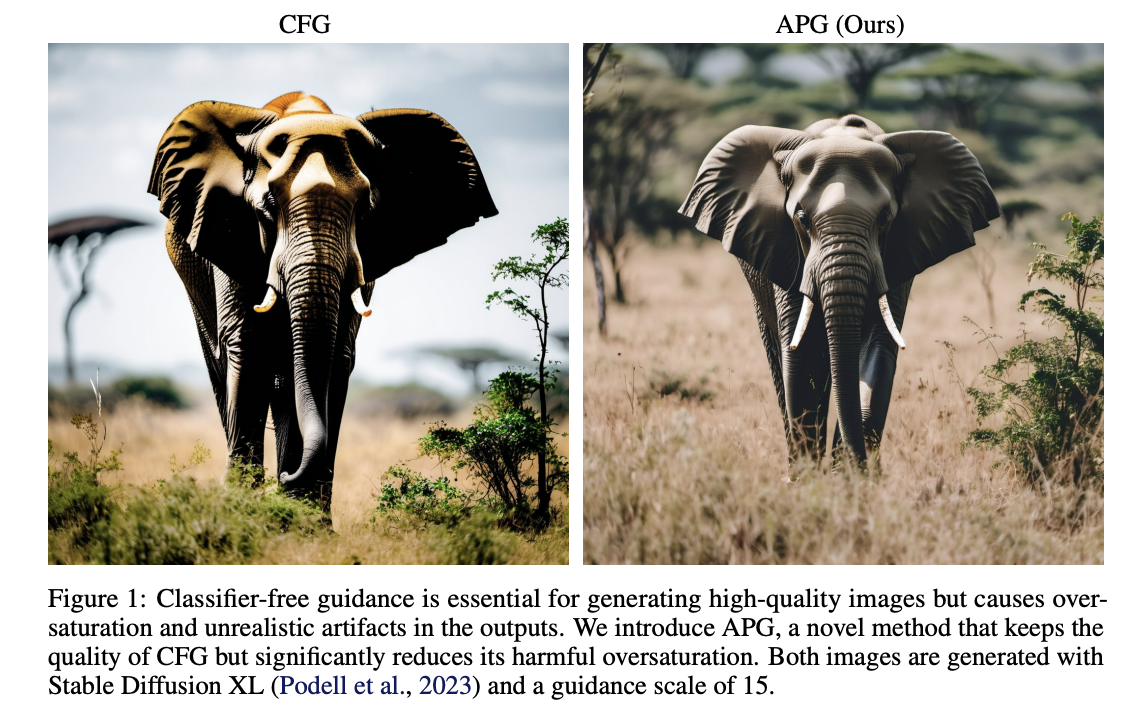

Classifier-Free Guiding, or CFG, is a major factor in enhancing picture generation quality and guaranteeing that the output closely matches the input circumstances in diffusion models. A large guidance scale is frequently required when utilizing diffusion models to improve image quality and align the generated output with the input prompt. Using a high guidance scale has the drawback of potentially introducing artificial artifacts and oversaturated colors into the output photos, which lowers the overall quality.
In order to overcome this issue, scholars re-examined the functioning of CFG and suggested modifications to enhance its efficiency. Their method’s core idea is to divide the CFG update term into two parts, an orthogonal component and a component parallel to the model’s prediction. They found that while the orthogonal component improves the image quality by bringing out details, the parallel component is mostly to blame for oversaturation and unnatural artifacts.
Building on this discovery, they put up a plan to lessen the parallel component’s influence. The model can still provide excellent photos without the undesirable side effect of oversaturation by down-weighting the parallel term. With greater control over image production made possible by this change, higher guidance scales can be used without sacrificing a realistic and well-balanced result.
Furthermore, the researchers discovered a link between the concepts of gradient ascent, a popular optimization technique, and how CFG functions. They found a unique rescaling and momentum technique for the CFG update rule based on this realization. While the momentum technique, which is comparable to adaptive optimization methods, improves the effectiveness of the update process by considering the influence of previous stages, rescaling aids in controlling the size of updates during the sampling phase, ensuring stability.
The advantages of CFG are still present in the new method, adaptive projected guidance (APG), which enhances image quality and aligns with input circumstances. However, one big benefit of APG is that it allows the utilization of higher guidance scales without worrying about oversaturation or unnatural artifacts. APG is a workable substitute for better diffusion models since it is very simple to use and virtually eliminates additional computational strain during the sampling procedure.
The researchers have shown via a set of tests that APG functions effectively with a range of conditional diffusion models and samplers. Key performance indicators like Fréchet Inception Distance (FID), recall, and saturation scores were all enhanced by APG while maintaining a precision level comparable to that of conventional CFG. Because of this, APG is a better and more adaptable plug-and-play solution that produces high-quality images in diffusion models more effectively and with fewer trade-offs.
Check out the Paper. All credit for this research goes to the researchers of this project. Also, don’t forget to follow us on Twitter and join our Telegram Channel and LinkedIn Group. If you like our work, you will love our newsletter.. Don’t Forget to join our 50k+ ML SubReddit
[Upcoming Event- Oct 17 202] RetrieveX – The GenAI Data Retrieval Conference (Promoted)
The post Refining Classifier-Free Guidance (CFG): Adaptive Projected Guidance for High-Quality Image Generation Without Oversaturation appeared first on MarkTechPost.